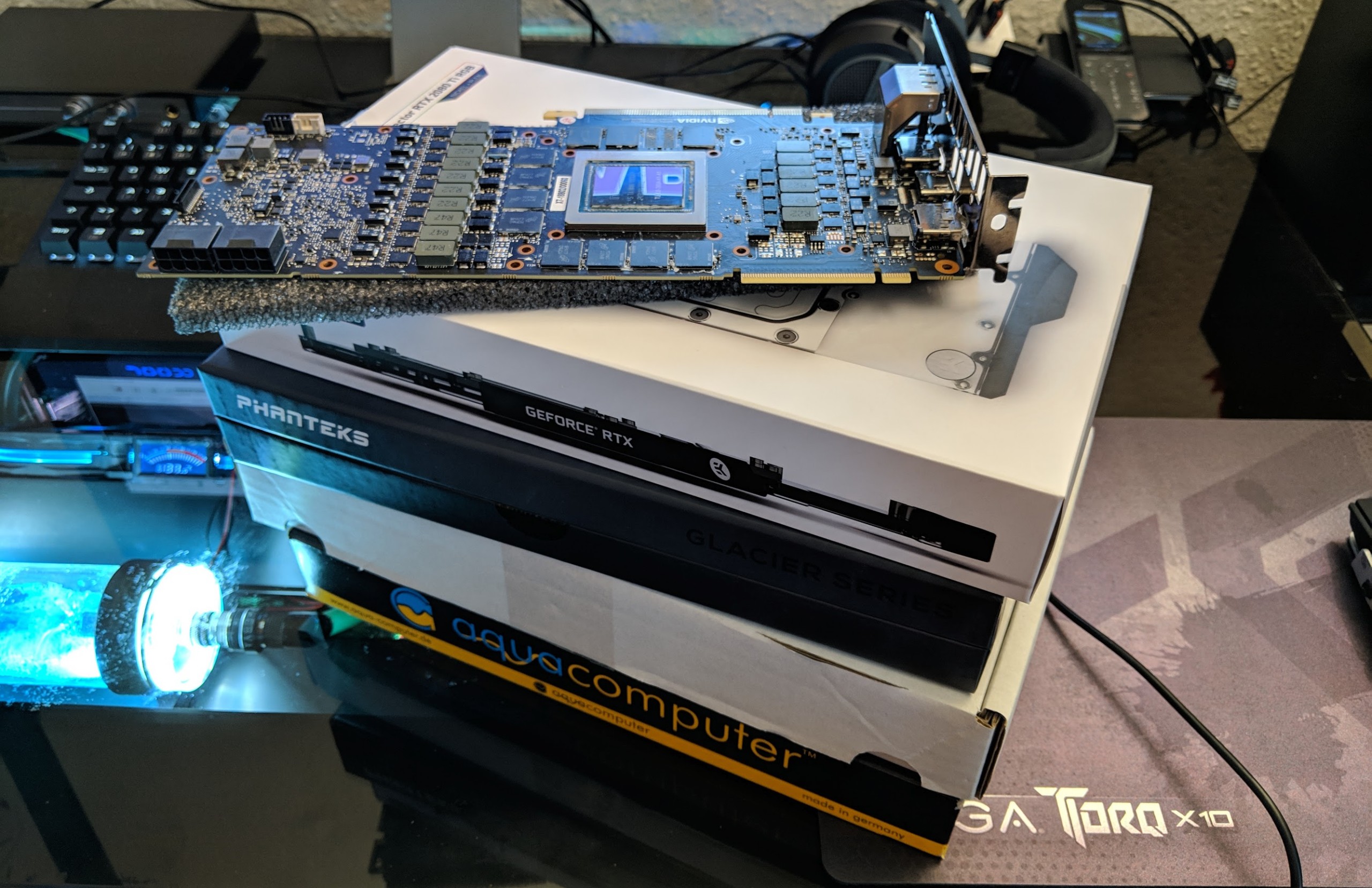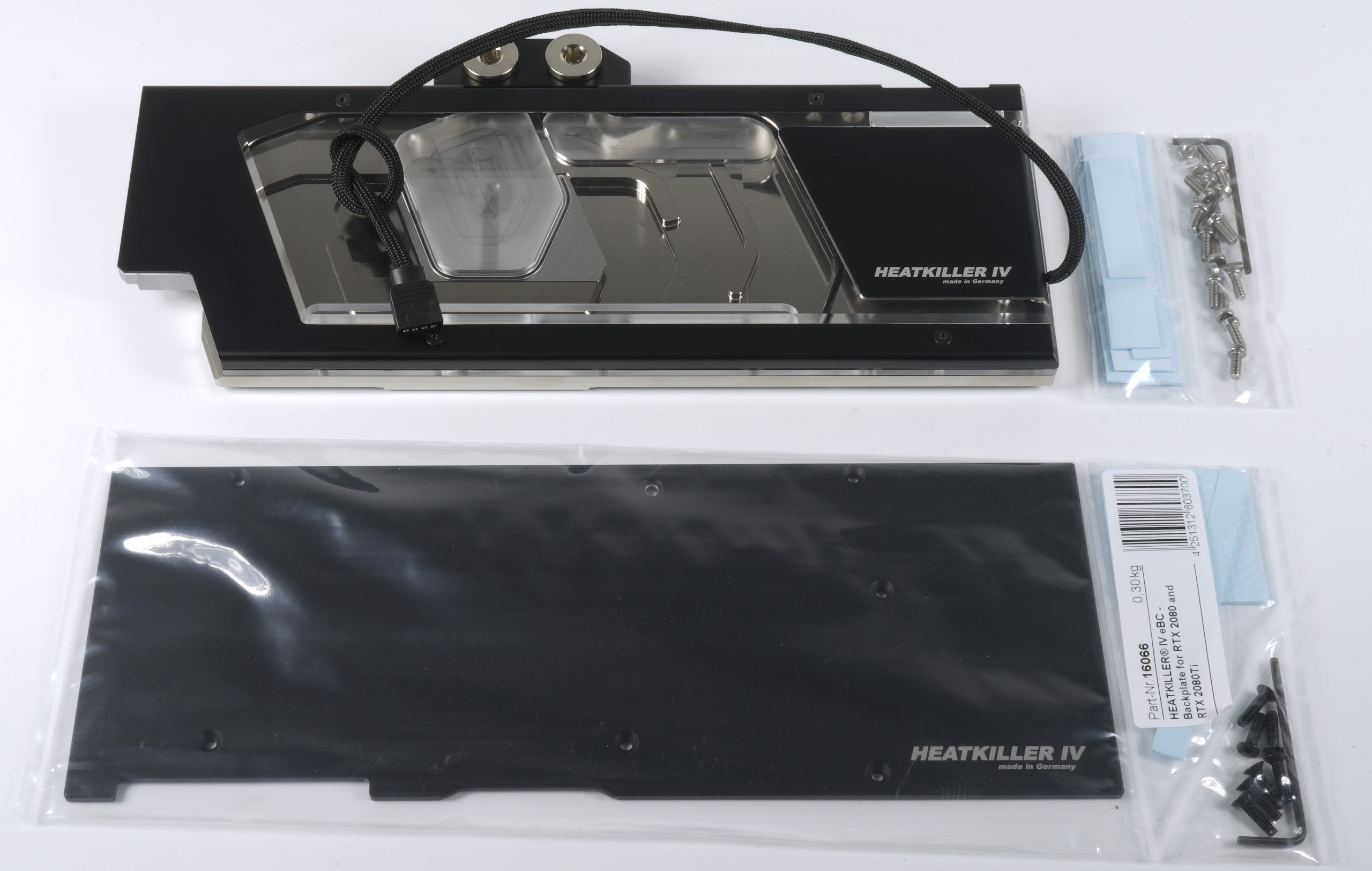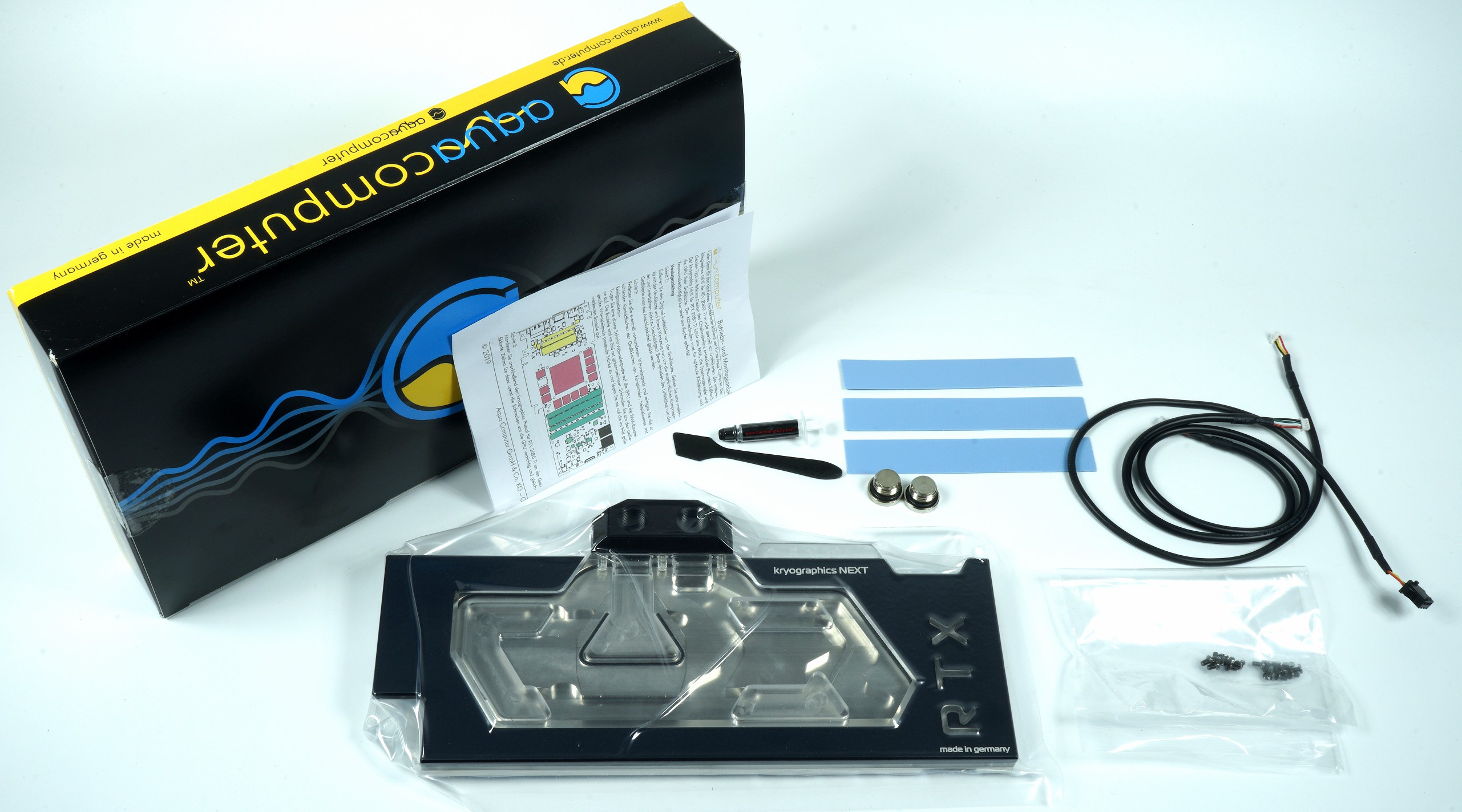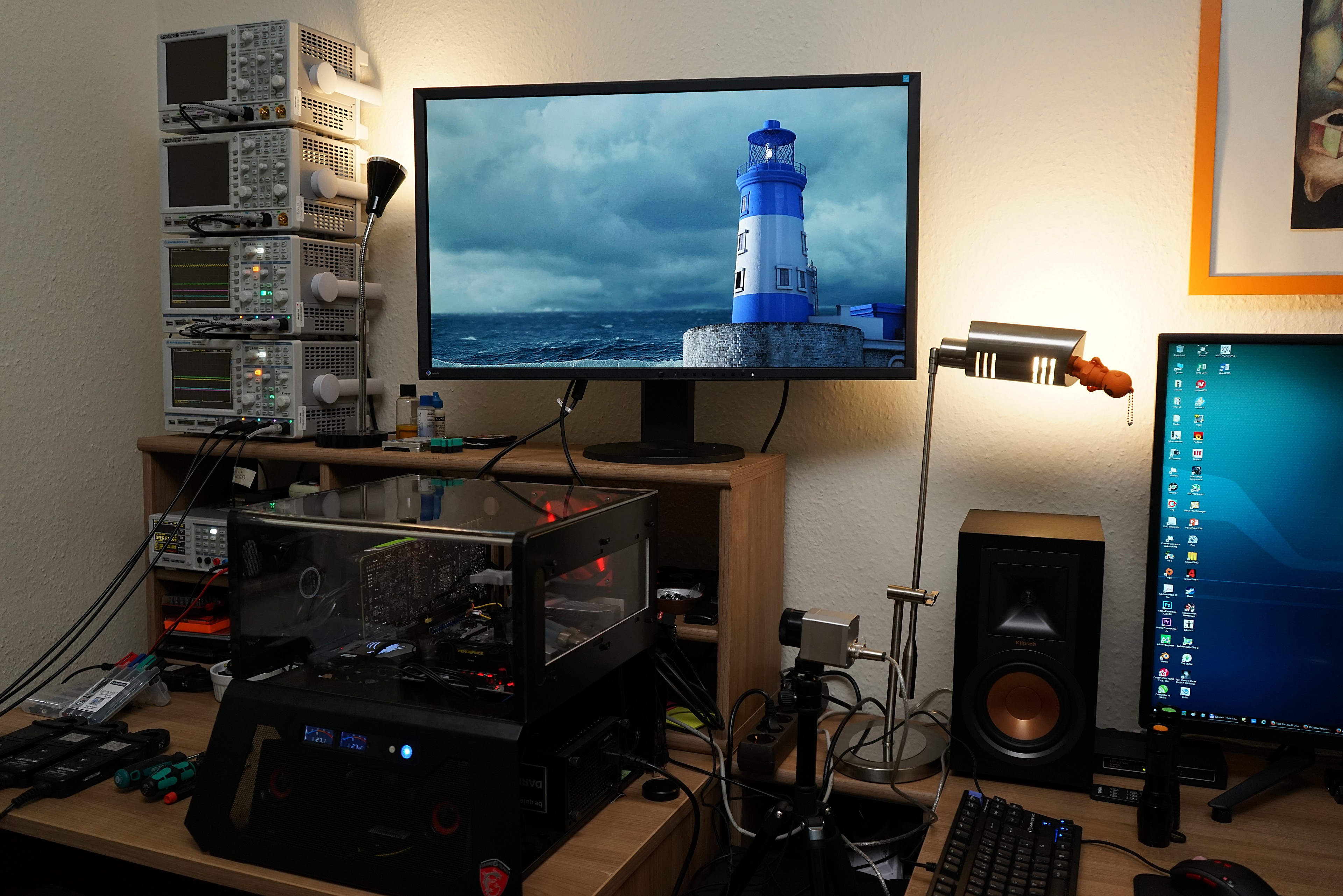All good things are four, the rest of the vendors have unfortunately either refused with their products or unfortunately could not deliver. This is annoying in itself, but it cannot be changed. In addition, two of the prototypes sent to me never made it on the market after the test. Here, the two sides have always treated each other fairly. The combined result of all individual tests is now available today.
I would like to start with the short individual summaries for each product in the chronological order of the tests. And yes, there is even a clear winner, with two coolers in particular outstanding.
EK Water Blocks EK-Vector RTX 2080 Ti RGB
The pre-assembled and also tight-tested water block, screws including washers, hexagonal socketwr, thermal guide pads, thermal conductive paste and two plugs are supplied. The RGB light chain has also been installed ex-factory. Even if there is currently no information on the homepage and in the data sheet (EK will supplement this according to my notice), it is currently the 12V version. A 5V version is still to follow.
What is always striking at EK, however, is the fact that the thread attachments screwed in on the back are very loose. If you want to tighten a screw here and remove it later, you almost always turn out these inserts and not the screws themselves. This is then extremely fiddly, brings senseless voltages into the board and can only be solved again by means of pliers.
Thanks to the EK Vector RTX 2080 Ti RGB, EKWB works with thin 0.5 mm pads for memory, which indicates good temperatures of the modules and also hardly provokes tensions in the PCB. The GPU is therefore absolutely flat. The Smart Power Stages (SPS) are connected to the cooler via 1 mm pads. Here the manufacturer obviously lacked the courage to stay thinner and pull the heatsinks deeper. That is a bit of a pity.
To the single test (new window)
EK Water Blocks Quantum Line EK-Quantum Vector RTX 2080 Ti RGB, Nickel, Acryl (3831109810477)
Phanteks Glacier RTX 2080Ti FE
The completely assembled water block, screws with acrylic washers, various thermal pads, thermal conductive paste and two plugs are supplied. The RGB light chain is integrated in the acrylic cover and is later brought to life by a pluggable adapter. Interestingly, only a normal small 3-pin Molex connector plus adapter plug is used here, which Phanteks calls an addressable RGB LED connector and which requires a special adapter for suitable motherboards.
If the motherboard does not offer this option, only a handle remains in the Phanteks accessory box or the purchase of a suitable motherboard. The scope of delivery is otherwise sufficient, the packaging stable, the instructions more or less plausible. So there is no need to write more on this point. Everything is in it, everything in it. point and fits.
Phanteks uses the Glacier G2080Ti throughout the thicker 1mm pads for memory and voltage converters, as well as the coils from the voltage converter range, while not cooling the flat caps. But even so, a decent cooling surface is already coming together.
The pre-assembled and pre-cut pads are relatively soft and stick better on the blue side than on the grey one. Therefore, you should put them on it as you can see it in the picture above. If not, you quickly run the risk that when turning the board over before putting it on the cooler, they will fall off again. That would be quite annoying and useless.
To the single test (new window)
Phanteks Glacier RTX 2080Ti Founders Edition schwarz (PH-GB2080TiFE_BK01)
Watercool Heatkiller IV RTX 2080 Ti Acrylic Ni RGB
The completely assembled water block, screws with acrylic washers, various thermal guide pads, as well as two plugs also come to the customer. The RGB light chain is integrated in the acrylic cover. One relies on one of the now more widely used 12V connections for color control, e.g. via the motherboard, which also explains the length of the connection cable.
What is missing from the accessories are a good thermal paste and an H6 hexagonal key for the plugs. The supplied screws are also made of a very soft metal and you have to be hellish lycareful when tightening, not to damage the heads. I can only advise everyone to use neat bits and a good (torque) screwdriver instead of the supplied tool.
The block itself consists of the common, nickel-plated electrolyte copper. With its 262.5 mm length, 117.25 mm height and 18.5 mm depth as a gross dimension including connection terminal, the cooler is quite large and weighs at 1250g also not very little. What is positive lynotal are the plastic spacers used, which hold significantly tighter than the screwed-in thread holders in other coolers.
With the Heatkiller IV, Watercool uses the thicker 1 mm pads for the voltage converters, coils and capacitors from the voltage converter range, while the flat memory modules are sensibly cooled with the thinner 0.5 mm pads. The thinner a pad, the lower the thermal resistance and the cooler the storage remains as a result. Well thought along. The pre-assembled and pre-cut pads are relatively soft and stick slightly better on the side with the pattern than on the smooth one.
To the single test (new window)
Watercool Heatkiller IV RTX 2080 Ti, Acryl Ni RGB (15621)
Aqua Computer Kryographics NEXT 2080 Ti
The completely assembled water block, screws, three 0.5 mm thermal guide pads, as well as two plugs and (far too little) thermal conductive paste are supplied. THE RGB lighting is integrated in the acrylic cover. With RGBpx you rely on an exclusively addressable RGB port, which can be connected to CONTROL units of Aqua Computer, but not directly to every motherboard with RGB control, which is really a pity.
The accessories thus provide the RGBpx cable and a connection to another RGBpx device. Some Asus motherboards now have such a connection, including various products from Corsair, NZXT or InWin. But a backward-compatible option would be really nice. Upon request, Aqua Computer announced that it would offer a solution in the foreseeable future.
What is missing in the accessories, however, are an H6 hexagonal key for the plugs and sufficient thermal paste. A special feature of the kryographics NEXT is the otherwise very pleasing circumstance that GPU and memory directly connect thermally to the cooling block by means of thermal paste. From a cooling performance point of view, this is a significant increase in quality, but it is also not always so easy to implement.
The one from approx. 1.8 kg of raw material in Germany CNC-milled solid copper cooling block is nickel-plated and, as already mentioned, weighs approx. 1250 grams. the spacers are fit tight enough and are not as easy to turn out as the EK RTX 2080 Ti from EK Water Blocks. The included small Phillips screws are ok, but the head could have been a little bigger.
The thin thermal pads logically have a lower thermal resistance than the 1 mm pads, which are unfortunately used so often, but require a very tailor-made production. Any tolerance violation would therefore be punished immediately during assembly. The cooling block was and is difficult to deliver, so i can only refer interested parties directly to the manufacturer.
To the single test (new window)
Test system and measurement methods
I have already described the test system and the methodology in the basic article "How we test graphics cards, as of February 2017" (English: "How We Test Graphics Cards") in detail and therefore, for the sake of simplicity, now only refers to these detailed Description. So if you want to read everything again, you are welcome to do so.
If you are interested, the summary in table form quickly provides a brief overview:
| Test systems and measuring rooms | |
|---|---|
| Hardware: |
Intel Core i7-6900K -4.5GHz MSI X99S XPower Gaming Titanium G.Skill TridentZ DDR4 3600 1x 1 TByte Toshiba OCZ RD400 (M.2, System SSD) 2x 960 GByte Toshiba OCZ TR150 (Storage, Images) Be Quiet Dark Power Pro 11, 850-watt power supply |
| Cooling: |
Alphacool Ice Block XPX 5x Be Quiet! Silent Wings 3 PWM (Closed Case Simulation) Thermal Grizzly Kryonaut (for cooler change) |
| Housing: |
Lian Li PC-T70 with expansion kit and modifications |
| Monitor: | Eizo EV3237-BK |
| Power consumption: |
non-contact DC measurement on the PCIe slot (Riser-Card) non-contact DC measurement on the external PCIe power supply Direct voltage measurement on the respective feeders and on the power supply 2x Rohde & Schwarz HMO 3054, 500 MHz multi-channel oscillograph with memory function 4x Rohde & Schwarz HZO50, current togor adapter (1 mA to 30 A, 100 KHz, DC) 4x Rohde & Schwarz HZ355, touch divider (10:1, 500 MHz) 1x Rohde & Schwarz HMC 8012, digital multimeter with storage function |
| Thermography: |
Optris PI640, infrared camera PI Connect evaluation software with profiles |
| Acoustics: |
NTI Audio M2211 (with calibration file) Steinberg UR12 (with phantom power for the microphones) Creative X7, Smaart v.7 own low-reflection measuring room, 3.5 x 1.8 x 2.2 m (LxTxH) Axial measurements, perpendicular to the center of the sound source(s), measuring distance 50 cm Noise in dBA (Slow) as RTA measurement Frequency spectrum as a graph |
| Operating system | Windows 10 Pro (1803, all updates) |







































Kommentieren